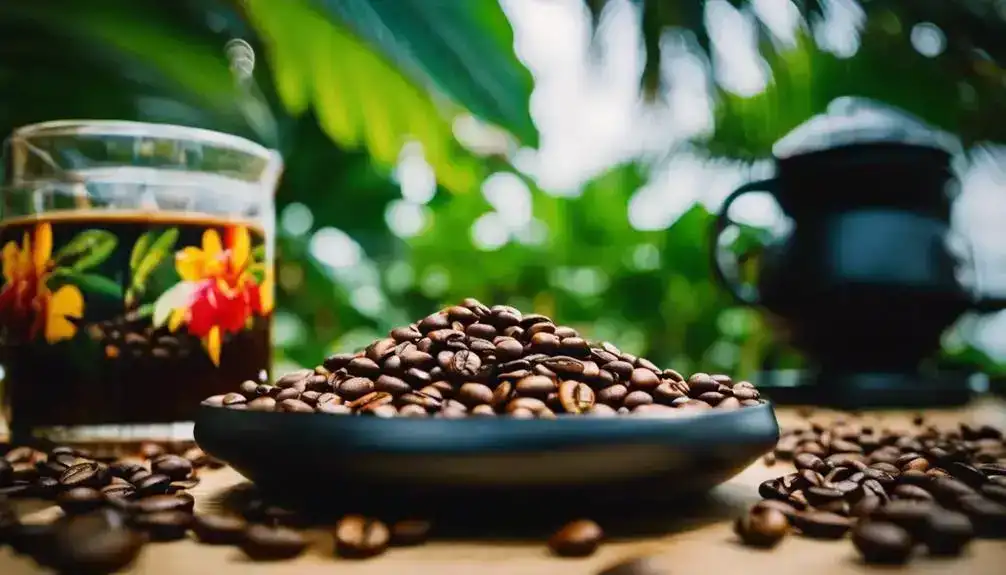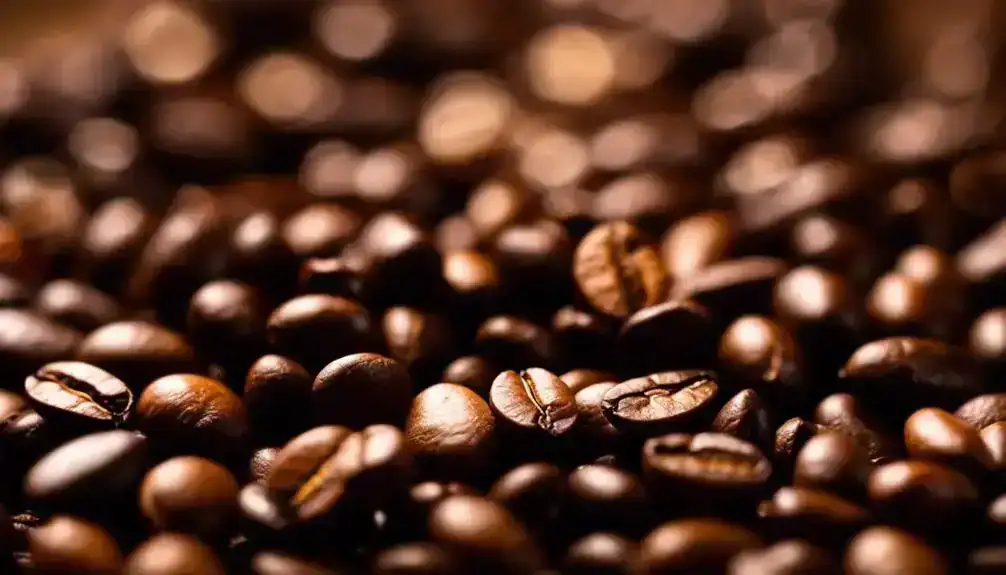When comparing Excelsa Coffee to Barako, notable differences arise. Excelsa, thriving in medium altitudes, boasts a full-bodied taste with fruity hints, ideal for blending complexity. In contrast, Barako, flourishing on high mountain slopes, offers floral and fruity aromas with a smoky body, perfect for bold brews. Excelsa originated from Africa and got reclassified under Liberica, known for its unique flavors. Meanwhile, Barako, cultivated in the Philippines since the 1740s, holds significant cultural symbolism as Kapeng Barako. With Excelsa’s limited supply and Barako facing endangerment, exploring their distinct bean characteristics and most suitable brewing techniques further reveals the depth of Filipino coffee culture.
Brief Overview of Excelsa Coffee vs. Barako

When exploring Filipino coffee icons, comparing Excelsa Coffee with Barako reveals distinct characteristics and histories unique to each variety. Excelsa thrives in medium altitude regions like Batangas, Quezon, and Sorsogon, while Barako grows well on high mountain slopes in Batangas and Cavite.
Excelsa boasts a full-bodied, strong, and tart flavor with fruity notes, ideal for adding complexity to blends. On the other hand, Barako offers a floral and fruity aroma with a full, smoky body, accompanied by woody, slightly nutty, and earthy undertones. The almond-shaped, medium-sized beans of Excelsa contrast with the larger, asymmetrical beans of Barako.
Excelsa’s dark and fruity aroma sets it apart from Barako’s intense floral and fruity scent. In the coffee market, Excelsa is popular in specialty blends, enhancing depth and complexity, while Barako holds a symbolic significance in Filipino culture, with rare availability globally. Both varieties bring unique flavors and aromas to the table, showcasing the rich diversity of Filipino coffee.
Comparative Analysis of Excelsa and Barako Coffee

Excelsa and Barako, two Philippine coffee icons, exhibit distinct origins, bean characteristics, flavors, market presence, and brewing methods.
Excelsa, with African roots and a reclassification under Liberica, offers a full-bodied taste with fruity notes, ideal for blending.
On the other hand, Barako, historically significant and symbolizing strength in Filipino culture, boasts floral and fruity aromas with a smoky body, perfect for traditional bold brews.
These differences make each coffee unique in its own right, appealing to different preferences and coffee experiences.
Origin and Classification of Excelsa Coffee vs. Barako
Excelsa coffee, originating from Africa and reclassified under Liberica in 2006, boasts unique flavors that set it apart.
On the other hand, Barako coffee, cultivated in the Philippines since the 1740s, holds significant cultural symbolism as Kapeng Barako.
Understanding the historical background and reclassification of Excelsa, alongside the cultural significance and symbolism of Barako, provides key insights into these iconic Filipino coffee varieties.
Historical Background and Reclassification
Barako, historically significant and deeply embedded in Filipino coffee culture, has been cultivated in the Philippines since the 1740s.
Cultivation History: Barako has a rich history dating back to the 18th century.
Reclassification: While Excelsa has origins in Africa, it was reclassified under Liberica in 2006.
Geographical Influences: Barako thrives in high mountain slopes, influencing its bold flavor profiles.
Cultural Significance and Symbolism
With a rich history dating back to the 18th century, Filipino Barako coffee holds deep cultural significance and symbolic value in the local coffee culture.
- Symbolic significance in Filipino heritage.
- Iconic representation of national pride.
- Embedded in cultural traditions.
Barako, known as Kapeng Barako, symbolizes strength and boldness, showcasing the resilience and vigor of Filipino coffee traditions.
Bean Characteristics of Excelsa vs. Barako
Excelsa and Barako beans exhibit noticeable differences in size and shape. Excelsa boasts almond-shaped, medium-sized beans, while Barako showcases larger, asymmetrical beans.
Additionally, the growth and harvesting methods for these two coffee varieties also vary greatly. Excelsa thrives in medium-altitude regions like Batangas, Quezon, and Sorsogon. It grows on large trees akin to Liberica. On the other hand, Barako flourishes on high mountain slopes in Batangas and Cavite. It produces large, asymmetrical beans on tall trees.
Size and Shape Differences between Excelsa and Barako Beans
The size and shape differences between Excelsa and Barako beans are notable features distinguishing these two Filipino coffee varieties. Excelsa beans are almond-shaped and medium-sized, while Barako beans are larger and asymmetrical. These distinctions impact the roasting techniques and flavor profiles of the coffee derived from these beans. See the table below for a visual comparison:
| Bean Type | Size | Shape |
|---|---|---|
| Excelsa | Medium-sized | Almond-shaped |
| Barako | Larger | Asymmetrical |
Growth and Harvesting Differences between Excelsa and Barako Beans
Harvested from different regions in the Philippines, Barako beans flourish on high mountain slopes while Excelsa beans thrive in medium altitude areas. Barako prefers high altitude regions with well-drained volcanic soil, while Excelsa grows best in loamy soil at elevations around 300 to 600 meters. Barako is typically handpicked during the dry season, whereas Excelsa is harvested year-round due to its resistance to pests and diseases.
| Aspect | Barako | Excelsa |
|---|---|---|
| Soil Requirements | Well-drained volcanic soil | Loamy soil |
| Altitude Preferences | High mountain slopes | Medium altitude (300-600 meters) |
| Harvesting Techniques | Handpicked during dry season | Year-round harvesting |
| Seasonal Variations | Dry season | Resistant to pests and diseases, harvested year-round |
Flavor Comparison of Excelsa vs. Barako
When comparing the flavor profiles of Excelsa and Barako coffee, you’ll notice distinctive differences. Excelsa boasts a full-bodied, strong taste with tart fruity notes, while Barako offers a floral and fruity aroma with a smoky, earthy undertone.
Excelsa tends to be darker and intense, whereas Barako presents a bold and robust flavor profile.
Distinctive Taste Notes of Excelsa vs. Barako
Excelsa and Barako coffee varieties offer distinct taste notes that set them apart in the world of Filipino coffee.
- Excelsa: Full-bodied, strong, and tart with fruity notes.
- Barako: Floral and fruity aroma with a full, smoky body.
- Excelsa: Often dark and intense, used for complexity in blends.
- Barako: Known for its woody, slightly nutty, and earthy taste.
Unique Aromas of Excelsa vs. Barako
Barako coffee emanates an intense floral and fruity aroma that sets it apart in the world of Filipino coffee varieties.
Excelsa, on the other hand, boasts a dark and fruity aroma, providing a unique olfactory experience.
When comparing the aroma profiles of these two iconic Filipino coffees, the differences in their scent comparisons become evident, showcasing the diverse sensory appeal each coffee brings to the table.
Market and Consumption of Excelsa vs. Barako
When comparing the market and consumption of Excelsa and Barako coffee, it’s evident that Excelsa is more widely used in specialty blends, enhancing complexity and depth due to its intense flavors.
On the other hand, Barako holds a symbolic value in Filipino coffee culture, though it remains rare in global markets and faces an endangered status.
The availability of Excelsa is limited, being considered a specialty coffee, while active efforts are in place to preserve the endangered Barako variety.
Popularity of Excelsa vs. Barako in the Coffee Market
The contrasting popularity of Filipino coffee icons in the market reflects their unique roles and significance within the coffee industry.
- Excelsa is sought after in global demand for its intense flavor.
- Barako, favored by local preferences, symbolizes boldness in Filipino culture.
- Excelsa shines in specialty blends, while Barako remains rare globally but integral to Filipino coffee traditions.
Availability and Rarity of Excelsa vs. Barako
Excelsa coffee is known for its limited supply and specialty status in the coffee market. It is sought after for its uniqueness, adding to its allure among coffee enthusiasts.
Barako coffee, on the other hand, is facing an endangered status and requires ongoing preservation efforts to ensure its survival for future generations.
The contrasting availability of these two types of coffee has a significant impact on the market. Excelsa’s scarcity contributes to its desirability, making it a coveted choice for those seeking unique coffee experiences. In contrast, Barako’s rarity poses challenges for widespread consumption, highlighting the importance of conservation measures to protect this valuable coffee variety.
Brewing Methods for Excelsa vs. Barako
When brewing Excelsa coffee, opt for strong brews and consider using it in blends to enhance complexity.
On the other hand, Barako coffee is best suited for traditional brewing methods, delivering a bold and robust flavor profile.
Whether enjoying Excelsa in rich blends or savoring Barako in traditional Filipino brews, these distinct coffee icons offer unique brewing experiences.
Optimal Brewing Techniques for Excelsa vs. Barako
For best brewing techniques for Excelsa and Barako coffee, consider adjusting the grind size based on your preferred method.
- Grind Size: Coarser for Barako’s bold flavors.
- Brewing Time: Longer for Excelsa’s complex blends.
- Water Temperature: Higher for Barako’s robust taste.
Adjust these factors to bring out the best in your cup of Excelsa or Barako coffee, enhancing your coffee pairing experiences and exploring new roasting techniques.
Popular Recipes and Serving Suggestions for Excelsa vs. Barako
Enhance your coffee experience with rich blends and robust flavors by exploring popular recipes and serving suggestions for Excelsa and Barako coffee.
- Coffee Pairing: Excelsa complements chocolate-based desserts, while Barako pairs well with traditional Filipino pastries.
- Flavor Profiles: Excelsa offers complex fruity notes, ideal for enhancing baked goods. Barako’s bold and smoky flavor elevates savory dishes.
- Serving Suggestions: Enjoy Excelsa in a French press for a balanced taste, and savor Barako in a traditional Filipino coffee sock for an authentic experience.
Conclusion
To sum up, the comparison between Excelsa and Barako coffee reveals the diverse and intriguing world of Filipino coffee culture. While Excelsa offers a unique flavor profile with its African origins, Barako stands out for its boldness and strength deeply rooted in Philippine tradition.
Both coffees bring a rich tapestry of history, flavors, and characteristics, making them iconic in their own right. Explore further into the world of Filipino coffee to truly appreciate the nuances and complexities each brew brings to the table.

